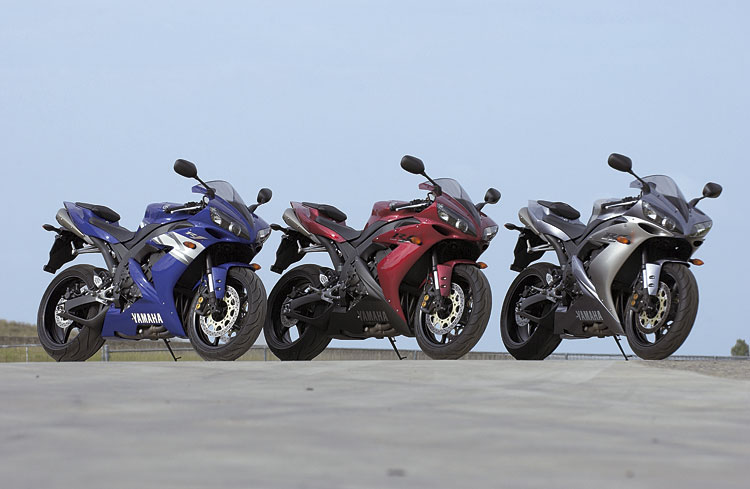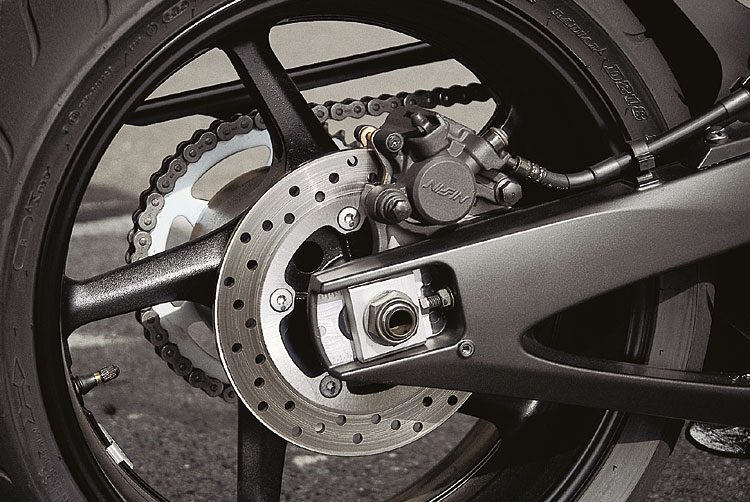Yamaha R1

No doubt about it, Michelangelo was one of the greatest artists ever and a free spirit the like of few others before or since. Trendsetters in architecture, music, fashion, cars, and bikes, Italians seem born with an eye for design. And when I first saw the original YZF-R1 in 1998, I had my suspicions there existed a pact between the Italians and the Japanese. The new model confirms it: Michelangelo had to be the inspiration behind the design, and, as for engineering and road performance, none other than Sir Isaac Newton could have lent a hand.
Half asleep, I opened the shutters and curtains of my gorgeous hotel room at the La Casa Del Zorro Desert Resort in Borrego Springs. An evening tour of the lodgings failed to reveal any proof of Don Diego's presence carved in the walls. And in the morning, with the last of my own "Zzzz's" evaporating above the headboard of the bed, my thoughts turned to the many R's waiting for us in the parking lot, namely Yamaha's R1. Sublime creations in two-tone colors (blue-white and silver-red), they sparkle in the morning light. The red one winks seductively, inviting me for a ride. Minutes later, much too excited to sample anything but the simplest of breakfasts on the varied menu, I head outside to inspect my companion for this sunny day.
Concept & Transformation
When Yamaha presented their first R1 in 1998, the concept was clear: Creating a lighter, faster bike with a more futuristic look became the "order of the day" to the technicians and design groups. With Michelangelo and Newton in mind, they had already done a fabulous job on the R1; but knowing how the competition never sleeps, the Yamaha Team kept burning the midnight oil over the years. Now, in 2004, they've grabbed our attention with a new, ground-up design. Lighter yet incredibly powerful, and even more beautiful aesthetically, aerodynamically, and ergonomically, this new creation certainly deserves that attention.

The lay-down cylinder block and resulting narrow frame produce a 4-cylinder bike that's slimmer and more compact than ever. The all-new, square, 20-valve Genesis 4 cylinder is designed to produce maximum horsepower at 12,500rpm (173 to be specific) and its 16-percent lighter, short-stroke crankshaft lets the revs build rapidly.
Engine & Transmission
Finally sitting on the bike, I close my AGV helmet, close all my zippers on my M-TECH two-piece riding gear, turn the key, and turn out of the parking lot onto Yaqui Pass Road.

Highway S3 winds over Yaqui Pass and in only seven miles, the elevation change goes from 590 feet to 1750 feet. Some of the steep turns surprise me and sometimes it looks as if I'm in the wrong gear, but the powerful engine excuses mistakes and convinces me with a wide range of midrange power. After a few miles, I'm already familiar with the bike. Shifting the gears is so much fun because the transmission has short ways that work very precisely. That's not a big surprise. It's only typical of Yamaha design and finishing, but some other manufacturers could learn a lot from this engineering marvel, especially the Europeans.
So what changes did Sir Isaac Newton inspire?

For one, a complete redesign of the 998cc engine. High silicon-content ceramic-composite cylinder sleeves ensure greater heat dissipation for consistent power delivery and reduced friction. On Hwy 78 up to Santa Ysabel, while swinging through tight corners and wide sweepers, I could attest that the handling is just perfect, an outstanding feeling that stems from three changes. The re-angled cylinder head, 40 degrees forward instead of 30, optimizes weight distribution, straightens intake tracts for improved cylinder filling, and allows the frame to pass over instead of around engine for greater strength. Saving 16 percent of the crankshaft weight has a tremendous impact too.
These technical aspects contribute significantly to good handling, as do many of the design elements. This is where Michelangelo meets Newton. The newly designed, ergonomic, two-piece fuel tank carries fuel in the rear section, effectively centralizing mass, while the front half contains a new, Ram-Air-fed air box for increased power.

With a strong lightweight clutch and close-ratio 6-speed gearbox with triangulated shaft layout for increased strength, compactness, and quicker acceleration installed in this tidy package, the two great geniuses of form and function surely would have applauded the result.
Chassis & Brakes
Escondido. I fly by. Ripping off approximately 90 miles on bumpy roads, I'm convinced that Yamaha has gone much farther than any other company in prompting us to come up with a new definition for the pure sport bike.

My ride was very comfortable without any signs of wrist or back pain ever cropping up. The improved ergonomics of the new aluminum Deltabox mainframe - width reduced from 464mm to 395.6mm - produce less stress while providing for a more efficient aerodynamic penetration. Its Deltabox mainframe passes over the engine now, not around it, in a structure that's 200 percent more rigid vertically, 50 percent stiffer laterally, and 30 percent stiffer torsionally.
My relaxed ride also owes something to the changed sitting position. The clip-on handlebars are 10mm higher; the foot pegs are 2.5mm further forward and 7.5mm lower.
So much for comfort. What about safety? I can't complain. Adhering to the lighter-but-stronger philosophy, Yamaha also saved weight on the brakes. The dual 320-mm front disc as well as the 220-mm rear disc delay perfectly. And more safe-ride components are evidenced in the fully adjustable KYB inverted telescopic front fork and the piggyback rear shock receiving stiffer springs, along with 5.1 inches of wheel travel, full adjustability and a lightweight, accessible aluminum preload adjustment collar. The Dunlop tires work well on the new 5-spoke wheels, another place where Yamaha saved weight - they're 10 percent lighter in front and 7.5 percent in the rear.

Chasing through the snaking racetrack of the R1, I zoom up to Palomar Mountain and the restaurant known as Mother's Kitchen. The bike's cornering clearance is phenomenal. An under-seat titanium exhaust, a lightweight system, reduces drag, enhances mass centralization, and allows for 56 degrees of cornering clearance.
Having so much fun, it is almost saddening to have to stop for lunch. But my stomach and throat have forced the issue. Afterward, even the fog and slippery road conditions that accompany me a good portion of the drop back down to Borrego Springs can do little to dampen my enthusiasm for this ride.

Test Summary
My impression after 250 miles is easy to describe. I'm floored! RoadRUNNER hereby presents the Sport Bike of 2004: The YZF-R1. The reasons are many but all told, it's simply a great package unmatched by any other machine in its class. Featuring a powerful engine transplanted in an incredibly good-looking body, it offers comfort, performance, superior handling, and numerous innovations. And though praiseworthy of Mr. Michelangelo and Sir Newton, Yamaha deserves all the credit.

Technical Specs
Retail Price $ 10,699
Warranty 1 year limited factory warranty
Maintenance Schedule 600/4000/every 4000 miles (1,000/6,400/every 6,400km)
Importer/Distributor Yamaha Motor Corp. USA
Engine
Type 4-cylinder, inline, four stroke
Cooling liquid cooled
Valve Arrangement5 valves per cylinder, 3 intake, 2 exhaust, DOHC chain driven
Bore & Stroke 77.0 x 53.6mm
Displacement 998cc
Compression Ratio 12.4:1
Carburetion dual-valve electronic fuel injection.
Exhaust Emission Control catalytic converter
Transmission
Gearbox 6-speed
Clutch wet multi-plate
Final Drive chain drive
Chassis
Frame DeltaBox V perimeter twin spar (aluminum)
Wheelbase 1395mm (54.9in)
Rake (horizontal/vertical)66°/24°
Trail 97mm (3.8in)
Front Suspension inverted telescopic fork
Stanchion Diameter 43mm
Adjustments spring preload, compression and rebound damping
Travel 120mm (4.72in)
Rear Suspension single shock w/piggyback reservoir
Adjustments spring preload, compression and rebound damping
Travel 130mm (5.12in)
Wheels & Tires
Type cast aluminum five spoke
Front 3.5 x 17
Rear 6 x 17
Front Tire 120/70-ZR17
Rear Tire 190/50-ZR17
Brakes
Front Brake 2 discs, 4-piston calipers
Diameter 320mm
Rear Brake single disc, 1-piston caliper
Diameter 220mm
Combining no
Dimensions & Capacities
Seat Height 835mm (32.9in)
Dry-Weight 172kg (379lb)
Fuel Capacity 18l (4.76gal)
Performance
Claimed Horsepower (measured at crank)180 hp at 12,500rpm
Torque 81.2ft-lbs at 10,500rpm
Top Speed 285kmh (175mph)
Acceleration 0-100km/h (0-65mph):3.2s
Fuel Consumption 6.5l/100km (36mpg)
Fuel Range 277km (170 mls)
Equipment
4 headlights, 2multi-reflector and 2 projector. New 5 spoke wheels. Analog tachometer. Digital speedometer, odometer, two tripmeters, low fuel meter, and lap timer.
RoadRUNNER Test Diagram
Engine 5/5
Chassis 5/5
Brakes 5/5
Comfort 4/5
Luggage w/accessories 3/5
Equipment 4/5
Design 5/5
Bike for the buck 4/5